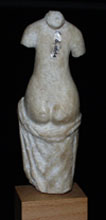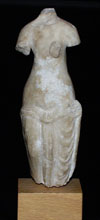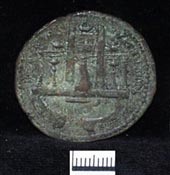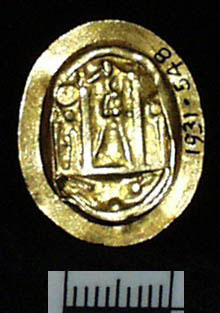Department of Antiquities
 |
Ashmolean Museum of Art and Archaeology |
|
|
| Presentations | |||
| Ancient
Cyprus in the Ashmolean Museum |
| Highlights of the Collection: Aphrodite, Female Figurines and Cyprus | |
| Aphrodite, Female Figurines and Cyprus: The Hellenistic Period |
|
The coin (left) is from the reign of the Roman Emperor Septimius Severus
(AD 193-211), whose face is on the obverse. The side visible here depicts
the Temple of Aphrodite at Paphos- the same design seen on the platelet
(right). There are two columns ending in points, joined by two crossbeams.
Above it, there is a star in a crescent and the cone is in the middle.
The inscription on the coin reads 'KOI NON KVPRWN', meaning that it
is a coin from Cyprus. The gold platelet is likely to have been intended
to slot into an amulet or ring. |
|||||
 |
 |
With the appearance on Roman coins of images of the main temple dedicated to Aphrodite, her importance and her connection with the economy are confirmed. The fertility cult on Cyprus had evolved into the worship of the Greek goddess Aphrodite (the Roman Venus) ... | |||
"And this has been her allotted province from the beginning among men and immortal gods: 'the whisperings of girls; smiles; deceptions; sweet pleasure, intimacy, and tenderness.'" (Hesiod, Theogony) |
|||||
|
Top: Bronze coin pf Septimus Severus, on loan from the Heberden Coin
Room |
Right: Gold Platelet from amulet or finger ring with depiction of the Temple of Aphrodite at Phaphos, purchased (AN1931.548) | ||
| Aphrodite Home | Next
Page Further Information |
||
| Ancient Cyprus Home | Top of Page |



 During
the Hellenistic period, 325-50 BC, most of the indigenous Cypriot religions
disappeared as all ritual matters came under state control. At this
point Cyprus could not really be distinguished religiously or materially
from the rest of the Hellenic world. The presence of the goddess Aphrodite
was symbolised in the aniconic cult by a conical stone, seen represented
here on the bronze coin and golden platelet.
During
the Hellenistic period, 325-50 BC, most of the indigenous Cypriot religions
disappeared as all ritual matters came under state control. At this
point Cyprus could not really be distinguished religiously or materially
from the rest of the Hellenic world. The presence of the goddess Aphrodite
was symbolised in the aniconic cult by a conical stone, seen represented
here on the bronze coin and golden platelet.